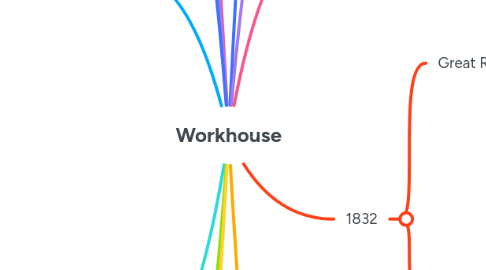
1. The new portal remained in operation for nearly 100 years
1.1. It was overhauled by The Local Government Act in 1929
1.1.1. But workhouses remained, they became less horrific
1.1.1.1. The National Assistance Act and the National Health Service Act were passed in 1948
1.1.1.1.1. the last remnants of the workhouses disappeared
1.1.1.1.2. the workhouses were converted into hospitals
2. Oliver Twist by Charles Dickens
2.1. story of a orphan child, who lives in a workhouse
2.1.1. "Please Sir I Want Some More"
3. structure
3.1. several connected blocks
3.2. similar to a prison
3.3. a wall around it
4. Punishments
4.1. eating bread and potatoes for 2 days
4.1.1. examples of causes
4.1.1.1. making a noise during silence
4.1.1.2. using bad language
4.1.1.3. not keeping clean
4.1.1.4. pretending to be sick
4.1.1.5. refusing to work
4.1.1.6. playing cards
4.2. being locked up for a day
4.2.1. examples of causes
4.2.1.1. insulting or disobeying the Master or Matron
4.2.1.2. hitting another pauper
4.2.1.3. getting drunk
4.2.1.4. damaging workhouse property
5. Daily Routine
5.1. hour of rising: 5:45am
5.2. breakfast: 6:30 - 7:00am
5.3. work: 7:00am - 12:00noon
5.4. lunch: 12:00 - 1:00pm
5.5. work: 1:00 - 6:00pm
5.6. dinner: 6:00 - 7:00pm
5.7. time for going to bed: 8:00pm
6. all meals must take place in silence
7. How was the life inside?
7.1. miserable, worse than prisons
7.1.1. these people were called "inmate"
7.2. it was perceived to be a punishment
7.3. family members were divided
7.3.1. men and women were divided
7.3.1.1. to stop the reproduction of the poor
8. What happened to the poor when they were admitted to the workhouse?
8.1. They were visited by a medical officer
8.1.1. people with disease
8.1.1.1. placed in the sick ward
8.1.2. healthy people
8.1.2.1. placed in the part of the workhouse according to their class
8.2. They were cleaned and then dressed in workhouse clothes
8.2.1. their heads were shaved
8.2.1.1. lost of identity
9. Help to the poor
9.1. 1601
9.1.1. help to the poor outdoors
9.1.1.1. managed by the parish which he collected taxes from the richest and then distributed them to the poor (who knew because it was small) below various forms
9.1.1.1.1. money
9.1.1.1.2. food
9.1.1.1.3. clothes
9.2. 1795
9.2.1. Speenhamland system
9.2.1.1. tied poor relief to the price of bread to distribute wages accordingly
9.2.1.2. popular in the agricultural south of England
9.3. demographic boom
9.3.1. difficulty in helping
9.4. Poverty during the Industrial Revolution
9.4.1. tough living conditions
9.4.1.1. there were not many rooms in houses
9.4.1.2. toilets were outside
10. Malthusian beliefs
10.1. Thomas Malthus
10.1.1. wrote Principle of Population, 1798
10.1.1.1. "Eventually population will outgrow and resources will not be enough"
10.1.1.2. 2 ways to keep this population in check
10.1.1.2.1. things that naturally kept the population low
10.1.1.2.2. preventative checks
11. Utilitarianism
11.1. Jeremy Bentham
11.1.1. "Utilitarianism strives for the greatest happiness for the greatest number of people or if you want to be nerdy about it logic clearly dictates that the needs of the many outweigh the needs of the few"
12. 1832
12.1. Great Reform Act
12.1.1. the culmination of years of political and social unrest across Britain
12.1.2. abolition of slavery
12.1.3. vote for the middle classes
12.1.3.1. increase in voter turnout in Great Britain
12.1.3.1.1. from 400,000 to 650,000
12.2. Royal Commission into the operation of the Poor Law
12.2.1. 9 commissioners
12.2.1.1. Nassau Senior
12.2.1.1.1. supporter of Thomas Malthus
12.2.1.2. Edwin Chadwick
12.2.1.2.1. influenced by Jeremy Bentham
12.2.2. Poor Law Commissioner' report of 1834
12.2.2.1. "The great source of abuse is the Out-door Relief afforded to the Able-bodied on their own account"
12.2.2.2. The overseers were corrupt
12.2.2.3. Workhouse test
12.2.2.3.1. working conditions inside the workhouses must have been worse than those of the poorer workers outside
13. The New Poor Law
13.1. it was passed in 1834
13.2. it forced people to enter a workhouse if they wanted help
13.2.1. what type of people?
13.2.1.1. poor
13.2.1.2. old
13.2.1.3. sick
13.2.1.4. unemployed
13.3. Was it a good or bad idea? Why?
13.3.1. supporter
13.3.1.1. It has cut the cost of paying for poor people
13.3.1.2. It kept people from being lazy and encouraged them to work harder
13.3.1.3. The old and the sick are still cared for and looked after in the workhouses
13.3.1.4. People had lessons inside the workhouses
13.3.1.4.1. knowledge, skills and education were increased
13.3.2. opponent
13.3.2.1. It treats poverty as a crime
13.3.2.2. The workhouses are cruel places
13.3.2.3. It is unfair to treat the poor in this way
